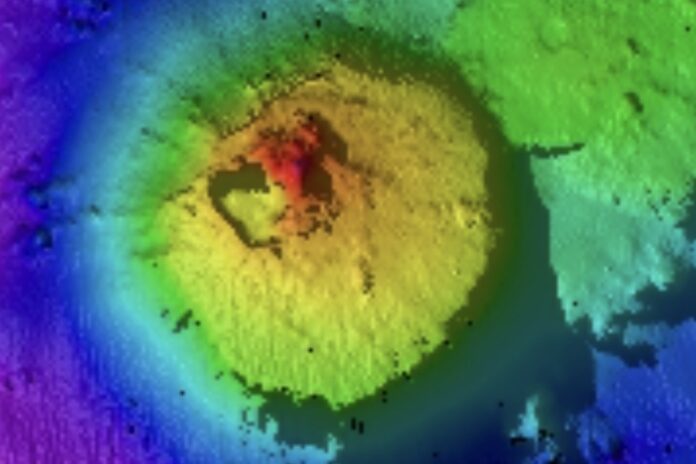Researchers have uncovered a massive underwater mountain that was previously unknown in the Pacific Ocean.
The mountain, known as a seamount, sits around 13,100 feet below sea level and peaks at a depth of roughly 7,900 feet. Rising 5,249 feet above the ocean floor, the underwater mountain is roughly twice as tall as the world’s tallest building—the Burj Khalifa in Dubai.
The seamount was identified by an expedition conducted by the Schmidt Ocean Institute (SOI) in international waters, around 84 miles outside the exclusive economic zone of Guatemala.
Seamounts are underwater mountains with steep sides that rise from the ocean floor, according to the National Oceanic and Atmospheric Administration (NOAA). Most seamounts are remnants of extinct volcanoes and they are often cone-shaped.
Schmidt Ocean Institute
These underwater geological features are numerous, found in every ocean basin around the world, although it is not known exactly how many there are. The number of seamounts measuring at least 1,000 meters (3,280 feet) high is thought to be greater than 100,000. But only a fraction of these have been explored.
The seamount found by the latest SOI expedition was observed using an instrument known as the EM124 multibeam echo sounder on the research vessel Falkor (too). This instrument is capable of high resolution mapping of the seabed.
After the echo sounder revealed the seamount, an onboard expert confirmed that the feature was not currently present in any ocean floor databases. The data showed that the underwater mountain covers an area of more than 5 square miles.
“A seamount over 1.5 kilometers [0.9 miles] tall which has, until now, been hidden under the waves really highlights how much we have yet to discover,” Jyotika Virmani, executive director of SOI, said in a press release.
“A complete seafloor map is a fundamental element of understanding our ocean so it’s exciting to be living in an era where technology allows us to map and see these amazing parts of our planet for the first time!”
Seamounts are hot spots of biodiversity, providing a surface where organisms such as deep-sea corals, sponges and a range of invertebrates can settle and grow. These organisms, in turn, provide food for other animals. Seamount ecosystems are often home to unique species that are found only in a single location.
The latest find is the third seamount that the research vessel Falkor (too) has discovered since launching in March. The two previous features were found in the Galápagos Islands Marine Reserve. In this time, the vessel has also identified three new hydrothermal vent fields, a new ecosystem underneath hydrothermal vents, and two pristine cold-water coral reefs.
“On every expedition, those aboard Falkor (too) have found the unexpected, the awe-inspiring, the new,” Wendy Schmidt, co-founder and president of SOI, said in the press release. “While there is so much we’ve come to understand as discoveries tumble ever faster into view, so much remains unknown in our ocean—and we are thrilled to continue exploring.”
Mapping and exploring unknown areas of the seafloor is a key element in understanding our planet. SOI is a partner in the Seabed 2030 initiative, which has set an ambitious goal of mapping the entire seafloor by 2030.
The lack of detailed maps for much of the seafloor hinders the ability to safely navigate vessels at sea, manage marine resources sustainably, and safeguard coastal communities.
“Yet another breathtaking discovery by the team onboard Falkor (too),” Jamie McMichael-Phillips, director of the Seabed 2030 Project, said in the press release. “We are hugely grateful to all at SOI for sharing essential information that will move us further towards our goal of delivering 100 percent seafloor mapping by the end of the decade.”
Uncommon Knowledge
Newsweek is committed to challenging conventional wisdom and finding connections in the search for common ground.
Newsweek is committed to challenging conventional wisdom and finding connections in the search for common ground.


